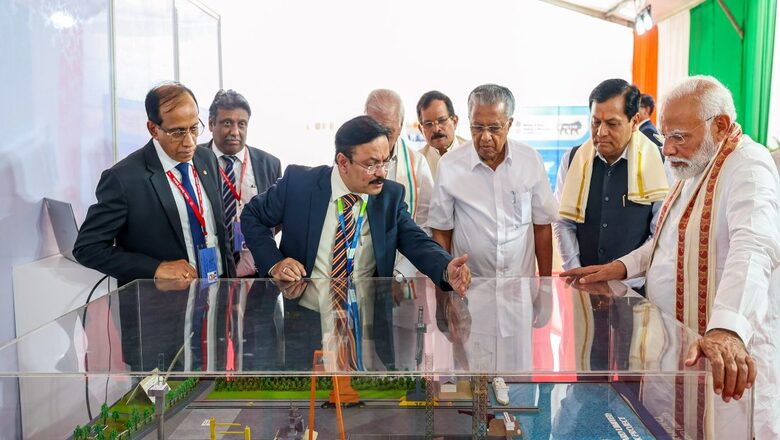
views
India is fast positioning itself as a country whose time to dominate the world’s shipping lanes has arrived. To that end, a lot of money and resources are being poured in, as became evident on Wednesday when Prime Minister Narendra Modi inaugurated projects worth Rs 4,000 crore in Kochi. These projects included a New Dry Dock (NDD) at the Cochin Shipyard, which is the first of its kind in the world. The prime minister also inaugurated Asia’s biggest International Ship Repair Facility (ISRF) and an LPG Import Terminal belonging to the Indian Oil Corporation at Puthuvypeen. The government says these major infrastructure upgradations will turn Kochi into a “one-stop maritime hub for repair needs of all vessels calling at Indian ports.”
Kochi’s New Dry Dock now places India among an elite group of nations that can manufacture large LNG carriers, Capesize and Suezmax vessels, oil rigs, semi-submersibles and other big vessels. The dock can also handle strategic assets like aircraft carriers of up to 70,000T displacement. That makes the New Dry Dock a long-term strategic investment which will serve India’s interests in more ways than one.
The International Ship Repair Facility at Kochi is equally important. Built at a cost of over Rs 970 crore, the repair facility can accommodate seven vessels of 130-metre length simultaneously. As a result, the facility will now be able to undertake repairs of about 84 ships every year, increasing India’s ship repair capacity by roughly 25 per cent.
The ship repair facility will serve as a strategic asset too. The situation in the Indo-Pacific is for all to see. China is getting increasingly aggressive against smaller nations in the region, particularly in and around the South China Sea. It is a well-known fact that one of the roles that the free world would like India to play is that of providing ship repair and replenishment services in times of conflict.
Such repair work is not just required by military vessels involved in conflict. In fact, the new repair facility will allow commercial as well as military ships travelling via the Indian Ocean Region, through the Malacca Strait, the option to get repair work done at Kochi. India is, therefore, set to emerge as a powerful alternative to China on this front. That explains why Kochi now has Asia’s biggest facility dedicated solely to the task of repairing ships.
Also Read: With Focus on Blue Economy and Eye on China, India is Working Towards Greater Maritime Heft
Together, the New Dry Dock and Ship Repair Facility will significantly reduce India’s dependence on other nations for shipbuilding and repair purposes. Along with the LPG Import Terminal at Puthuvypeen, the ongoing shipping and port infrastructure upgrade has the potential to transform southern and coastal states into a fulcrum of India’s rising maritime power. With a 15400 MT storage capacity, the LPG terminal will ensure millions of households and businesses in the region get a steady and uninterrupted supply of LPG. India will also be able to handle bigger LPG containers, benefitting the country’s energy security as a whole.
The markets were among the first to catch wind of the transformation India’s maritime sector is undergoing. They responded bullishly to the inauguration of major maritime assets in Kochi. Shares of Cochin Shipyard Limited surged 5.5 per cent to hit a new 52-week high in morning trade after the company opened the New Dry Dock and the International Ship Repair Facility in Kochi.
India’s Time to Shine in the High Seas
Recently, News18 had explained the significance of India’s proposed move to create its own protection and indemnity (P&I) insurance entity. Such an entity would provide not just India, but the whole world with an alternative to the West’s shipping insurance ecosystem. Having its own system of insuring ships will allow India to not be dependent on the West for the stability of its supply chains, while also allowing Global South countries to not be beholden to the “developed world”.
The push for having a domestic P&I entity has not come in isolation. India has, as a matter of fact, been making significant progress in uplifting and strengthening its maritime economy and putting itself on the global transit map. The Modi government is working on a plan called ‘Maritime India Vision 2030’ that seeks to develop world-class mega ports and transhipment hubs and modernise infrastructure at an estimated investment cost of Rs 1.25 trillion. In July 2023, Union Minister for Ports, Shipping and Waterways, Sarbananda Sonowal had said the Centre has identified investment opportunities worth more than Rs 10 lakh crore in the maritime sector, which are expected to generate no less than 15 lakh new jobs.
In 2023, the World Bank’s Logistic Performance Index (LPI) report had shed light on how India’s port infrastructure and ability to handle ships is witnessing a positive transformation.
- India has moved up to 22nd rank in the global rankings on the “International Shipments” category from the 44th position in 2014
- In 2015, the capacity of India’s 12 major ports stood at 871 million metric tonnes (MMT), but has now risen to 1,617 MMT
- At the same time, the total capacity of Indian ports has gone up from about 1,560 MMT in 2015 to more than 2,600 MMT now
- From 2015 to 2022-23, the value of operationalisation of public-private partnership projects in major ports has risen by 150 per cent from Rs 16,000 crore to Rs 40,000 crore
Initiatives like Sagarmala, Bharatmala, PM Gati Shakti, and the National Logistics Policy 2022 are playing an instrumental role in reducing the cost of logistics and improving the performance of not just India’s ports, but the wider logistics network in the country. As a result, since 2014, the average turnaround time for the major ports has decreased by about 50 per cent. The average turnaround time for Indian ports declined from 4.3 days in 2012-13 to 2.1 days in 2022-23.
India’s strategic investments in maritime infrastructure mark a significant step towards transforming the nation into a maritime power. These developments, coupled with the push for a domestic P&I insurance entity and broader initiatives like ‘Maritime India Vision 2030,’ underscore India’s commitment to independence as well as excellence in the global maritime domain. The journey to India becoming a global blue economy is not without its fair set of challenges, but it is a journey that an ambitious country like India cannot avoid.
Views expressed in the above piece are personal and solely those of the author. They do not necessarily reflect News18’s views.















Comments
0 comment